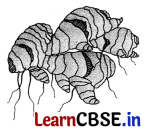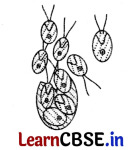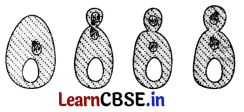We have given these Class 12 Biology Important Questions Chapter 1 Reproduction in Organisms to solve different types of questions in the exam. Go through these Class 12 Biology Chapter 1 Important Questions, Reproduction in Organisms Important Questions & Previous Year Questions to score good marks in the board examination.
Class 12 Biology Chapter 1 Important Questions Reproduction in Organisms
Question 1.
Identify the picture and mention the vegetative part that helps it to propagate. (All India 2015C)

Answer:
The given figure shows the rhizome of a ginger. Rhizome is an underground stem that takes part in vegetative propagation.
Question 2.
Name the vegetative propagules in the following: (All India 2014C)
(i) Agave
(ii) Bryophyllum
Answer:
The vegetative propagules in given plants are as follows
(i) In Agave – Bulbil
(ii) In Bryophyllum – Leaf buds/Adventitious buds
![]()
Question 3.
Write the name of the organism that is referred to as ‘Terror of Bengal’. (Delhi 2014)
Answer:
Water hyacinth is referred to as the ‘Terror of Bengal’.
Question 4.
Give one example each of a fungus which reproduces by (Delhi 2014C)
(i) budding
(ii) conidia
Answer:
Fungus that reproduces by
(i) budding – Yeast
(ii) conidia – Penicillium
Question 5.
Give one example of a plant that reproduces by (Delhi 2014C)
(i) runner
(ii) offset
Answer:
Below are is the example of a plant that reproduces by
(i) runner – Oxalis
(ii) offset -Pistia
Question 6.
Which of the following statements is true of Hydra? (All India 2013C)
(i) It produces asexual gemmules.
(ii) It produces unicellular buds.
(iii) It produces multicellular buds.
Answer:
(iii) Hydra produces multicellular buds.
Question 7.
Which one of the following statements is true of ginger? (All India 2013C)
(i) Germinating bud appears from the eye of the stem tuber.
(ii) Germinating bud appears from the node of rhizome.
(iii) Germinating bud appears from the notch of the leaf margin.
Answer:
(ii) The germinating bud appears from the node of rhizome in ginger.
Question 8.
Name an organism, where cell division is itself a mode of reproduction. (All India 2013; Foreign 2010)
Answer:
In unicellular organisms like Amoeba, bacteria, etc., cell division itself is a mode of reproduction.
Question 9.
How does Penicillium reproduce asexually? (Delhi 2013)
Answer:
Penicillium reproduces asexually by conidia formation, which are non-motile spores produced singly or in chains by the constriction of tip of hyphal branches. These spores germinate by giving out germ tubes.
Question 10.
Name an alga that reproduces asexually through zoospores. Why are these reproductive units so called? (All India 2013)
Answer:
Chlamydomonas is an alga that reproduces asexually through zoospores. Due to mobility (motile) like animals, these reproductive units are referred to as zoospores.
Question 11.
Which one of the following statements is true for yeast? (Delhi 2013C)
(i) The cell divides by binary fission.
One of them develops into a bud.
(ii) The cell divides unequally. The smaller cell develops into a bud.
(iii) The cell produces conidia, which develop into a bud.
Answer:
Statement (ii) is true for yeast. The cell divides unequally. The smaller cell develops into a bud.
Question 12.
Which one of the following organisms exhibit binary fission?
Bacillus, Penicillium, Yeast, Amoeba (Delhi 2012C)
Answer:
Bacillus and Amoeba reproduce by binary fission. In this mode, the body of an individual divides into two equal halves.
![]()
Question 13.
Offsprings produced by asexual reproduction are called clones. Justify giving two reasons. (All India 2010)
Answer:
Offsprings produced by asexual reproduction are called clones, because
- they are morphologically similar to their parent.
- they have same genetic composition as their parent.
Question 14.
Identify this reproductive structure and name the organism they are being released from. (Delhi 2010)

Answer:
The reproductive structure in the figure are zoospores. These are motile, microscopic and thin-walled structures released by Chlamydomonas for asexual reproduction.
Question 15.
Name the organism and the mode of reproduction represented in the diagram given below (All India 2010)

Answer:
Organism Yeast
Mode of reproduction Asexual by budding.
Question 16.
Banana crop is produced by farmers without sowing of seeds. Explain how the plant is propagated? (All India 2014C)
Answer:
Banana crop is cultivated by farmer’s through vegetative propagation.
For this purpose, a rhizome of banana is taken instead of a seed. Each piece from a rhizome is able to give rise to a new plant.
Question 17.
Unicellular organisms are immortal, whereas multicellular organisms are not. Justify. (Delhi 2011C)
Answer:
Unicellular organisms are considered immortal mainly because, in them the parent body as a whole constitutes the reproductive unit and after reproduction it continues to live as daughter cells. The multicellular organisms produce their reproductive structures in specialised organs and their whole body dies due to ageing and senescence.
Question 18.
(i) Name the organism that reproduce
through the following reproductive structures
(a) Conidia
(b) Zoospores
(ii) Mention similarity and one difference between these two reproductive units, (Delhi 2011C)
Answer:
(i) (a) Conidia – Penicillium
(b) Zoospore – Chlamydomonas
similarity
Question 19.
At what stage does the meiosis occur in an organism exhibiting haplontic life cycle and mention the fate of the products thus produced. (Delhi 2019)
Answer:
In organisms with haplontic life cycle, meiosis occur in the diploid cell, i.e., zygote which divides to form haploid spores. These spores grow into haploid individuals.
Question 20.
Write the number of chromosomes body cells of honeybee workers and drone have. (Delhi 2019)
Or
A male honeybee has 16 chromosomes whereas its female has 32 chromosomes. Give one reason. (Delhi 2016)
Answer:
In case of honeybees, the male (drones) have 16 chromosomes and females (queen and workers) have 32 chromosomes, because of incomplete parthenogenesis. Fertilised diploid eggs give rise to females by sexual reproduction and unfertilised haploid eggs develop into drones (males) by parthenogenesis.
Question 21.
Explain the significance of meiocytes in a diploid organism. (Delhi 2016)
Answer:
Most of the animals including human beings have diploid parental body and their gametes are formed by meiosis. In such organisms, specialised cells called meiocytes are present, which take part in the production of gametes.
between
Question 22.
Explain the importance of syngamy and meiosis in a sexual life cycle of an organism. (Delhi 2016)
Answer:
Syngamy It helps to restore the diploid condition in sexually reproducing organism by the formation of diploid zygote and thus ensuring the continuity of species.
Meiosis It helps in producing haploid gametes in sexually reproducing organisms.
Question 23.
A single pea plant in your kitchen garden produces pods with viable seeds, but the individual papaya plant does not. Explain. (All India 2015)
Answer:
A pea plant is monoecious or bisexual, hence even a single plant can produce seeds while papaya is dioecious, hence an individual plant alone cannot produce viable seeds.
![]()
Question 24.
How many chromosomes do drones of honeybees possess? Name the type of cell division involved in the production of sperms by them. (All India 2015)
Answer:
Drones of honeybees possess 16 chromosomes (haploid). They produce sperms by a mitosis¬like division, rather than meiosis.
Question 25.
Meiosis is an essential event in the sexual life cycle of any organism. Give two reasons. (Foreign 2015)
Answer:
Meiosis is an essential event in the sexual life cycle of any organism because
- It is a source of genetic variability.
- It helps to conserve the chromosome number of species from generation to generation.
Question 26.
Give one example of an animal which exhibits oestrus cycle. (Delhi 2014C)
Answer:
Example of an animal that exhibits oestrus cycle is cow.
Question 27.
Write the two pre-fertilisation events from the list given below Syngamy, Gametogenesis, Embryogenesis, Pollination (All India 2014C)
Answer:
Gametogenesis and pollination are pre-fertilisation events.
Question 28.
In which two of the following organisms is the fertilisation external?
Bony fishes, Ferns, Frogs, Birds (Delhi 2014C)
Answer:
Bony fishes and frogs exhibits external fertilisation.
Question 29.
Differentiate between oviparous and viviparous animals. (Delhi 2014C)
Answer:
In oviparous animals, embryo develops outside the body of female and they lay eggs, e.g. reptiles. On the contrary in viviparous animals, embryo develops inside the body of female. Thus, they give birth to babies, e.g. humans.
Question 30.
Give the name of the common phenomenon with reference to reproduction in rotifers, honeybees and turkeys. (Delhi 2013C)
Answer:
Parthenogenesis is the common phenomenon with reference to reproduction in rotifers, honeybees and turkeys.
Question 31.
Which of the following statements is true of date palm?
(i) It is monoecious producing both staminate flowers and pistillate flowers on the same plant.
(ii) It is monoecious producing staminate flowers on one tree and pistillate flowers on another tree.
(iii) It is dioecious producing staminate flowers on one tree and pistillate on another tree. (All India 2013C)
Answer:
(iii) Date palm is a dioecious plant which produces staminate flowers on one tree and pistillate flowers on another tree.
Question 32.
Cucurbits and papaya plants bear staminate and pistillate flowers.
Mention the categories they are put under separately on the basis of the type of flowers they bear. (Delhi 2012)
Or
How are Cucurbita plants different from papaya plant with reference to flowers they bear? (All India 2011C)
Answer:
Papaya is dioecious because the staminate and pistillate flowers are borne on two different plants, while Cucurbita is monoecious because it bears both staminate and pistillate flowers on the same plant.
Question 33.
Mention the unique flowering phenomenon exhibited by Strobilanthes kunthiana (Neelakurinji). (Delhi 2012)
Answer:
In the shrub plant, Strobiknthes kunthiana flowers bloom only once in twelve years.
Question 34.
Name the mode of reproduction that ensures the creation of new variants. (Delhi 2012C)
Answer:
The process of sexual reproduction ensures the creation of new variants. It involves the fusion of gametes from different parents (male and female) resulting into genetic recombination that leads to variations.
Question 35.
Name the type of cell division that takes place in the zygote of an organism exhibiting haplontic life cycle. (Delhi 2011)
Answer:
Meiosis is the type of cell division that takes place in the zygote of an organism exhibiting haplontic life cycle.
Question 36.
Name the phenomenon and the cell responsible for the development of a new individual without fertilisation as seen in honeybees. (Foreign 2011)
Answer:
The phenomenon of the development of a new individual without fertilisation is called parthenogenesis. In honeybees, egg cell undergoes parthenogenesis to form haploid drones (n).
![]()
Question 37.
Mention the site where syngamy occurs in amphibians and reptiles, respectively. (Delhi 2010)
Answer:
In amphibians, syngamy takes place outside the body of organism in water while in reptiles, it takes place inside the body of female organism.
Question 38.
A moss plant produces a large number of antherozoids but relatively only a few egg cells. Why? (Delhi 2010)
Answer:
The antherozoids or male gametes in moss plants are motile and depend on water for their transport towards female gametes (non-motile). During gamete transfer, large number of male gametes are lost. Thus, to ensure fertilisation, large number of male gametes are released in water so as to reach the non-motile female gametes.
Question 39.
Why are papaya and date palm plants said to be dioecious, whereas cucurbits and coconut palms monoecious, inspite of all of them bearing unisexual flowers? (Foreign 2010)
Answer:
Papaya and date palm plants are said to be dioecious because male and female flowers are borne on separate plants, whereas cucurbits and coconut palms are monoecious because male and female flowers are borne on the same plant.
Question 40.
(i) Why do organisms like algae and
fungi shift from asexual mode of reproduction to sexual mode ?
(ii) What is a juvenile phase in organisms ? (2018C)
Or
Why do algae and fungi shift to sexual mode of reproduction just before the onset of adverse conditions? (Delhi 2014)
Answer:
(i) Organisms such as fungi and algae switch to sexual mode of reproduction during adverse conditions because asexual reproduction produces a large population that may not survive due to lack of resources. Sexual reproduction brings variations among the individuals, that might help the individuals to better adapt to the changed conditions and to survive. This ensures the continuity of species.
conidia
Question 41.
Why do moss plants produce very large number of male gametes? Provide one reason. What are these gametes called? (All India 2015)
Answer:
Refer to Answer No. 20.
Question 42.
Coconut palm is monoecious, while date palm is dioecious. Why are they so called? (Delhi 2014)
Answer:
Refer to Answer No. 21.
Question 43.
The cell division involved in gamete formation is not of the same type in different organisms. Justify. (Delhi 2011)
Answer:
The gametes involved in sexual reproduction are usually haploid. Thus, in diploid organism cell division involved in gamete formation is meiosis, as it leads to the production of haploid gametes. However, in case of haploid organisms, gametes are formed due to mitotic cell division.
Question 44.
A list of three flowering plants is given below Date palm, cucurbits and pea.
Which ones out of them are
(i) monoecious
(ii) bearing pistillate flowers? (Foreign 2011)
Answer:
(i) Cucurbits and pea plants are monoecious bearing both staminate and pistillate flowers on the same plant.
(ii) Date palm, cucurbits and pea, all three bear pistillate flowers.
Question 45.
Name any two organisms and the phenomenon involved where the female gamete undergoes development to form new organisms without fertilisation? (Foreign 2011)
Answer:
Parthenogenesis helps in the development of new organisms without fertilisation, e.g. lizards, honeybees, etc. Refer to Answer. No. 2.
Question 46.
Differentiate between an annual and biennial plants. Provide one example of each. (Delhi 2017)
Answer:
Differences between annual and biennial plants are as follows
| Annual plants | Biennial plants |
| These plants complete their life cycle in 1 year. | These plants complete their life cycle in 2 years. |
| The vegetative and reproductive phases occur within a year only. | Flowering occurs during second year, after a year of vegetative growth. |
| Since, these plants require less time, they are of low maintenance. | Due to more time required in growing, these plants require of high maintenance. |
| e.g. cereals, legumes, marigold, Gerbera, etc. | e.g. trees, shrubs and some grasses, poppy, foxglove, etc. |
Question 47.
(i) List the three states the annual and biennial angiosperms have to pass through during their life cycle.
(ii) List and describe any two vegetative propagules in flowering plants. (Delhi 2017)
Answer:
(i) The three states through which the annual and biennial angiosperms pass during their life cycle are
- Vegetative or Juvenile phase
- Reproductive phase
- Senescent phase
(ii) Vegetative propagules are the parts/units of a plant which can be used for vegetative propagation, e.g. roots, stems, leaves, etc.
Root propagules are used for the production of a new plant via roots, e.g. fleshy roots in case of sweet potato, tapioca and Dahlia.
Vegetative propagation through leaves Many plant leaves have adventitious buds which help in the development of a new plant, e.g. Begonia, Bryophyllum, etc.
![]()
Question 48.
Vijay’s mother was preparing batter for dosa and added a small packet of dried yeast to the mixture. She left it for sometime and Vijay noticed that the level of batter has risen in the bowl. He asked his mother about his observation.
(i) Why was yeast added to the dosa batter?
(ii) Name and explain the process by which yeast multiplies.
Answer:
(i) Yeast was added to dosa batter to make it light and fluffy. Yeast divides very quickly and releases carbon dioxide which raises the batter in quick time.
(ii) Yeast reproduces by budding which is a type of asexual reproduction during budding unequal and small projections called buds are produced. These buds initially remain attached to parent body but later they detach to form new individuals.
Question 49.
Arjun saw an article on ‘Reproductive behaviours of various mammals in a magazine. For example, how some animals can reproduce throughout their life, while others cannot. He took the article to his teacher for further clarification.
(i) What is meant by term continuous breeders and seasonal breeders?
(ii) In non-primates, what is the phase of morphological and physiological changes known as?
(iii) List the values observed in Arjun.
Answer:
(i) Animals that remain reproductively active throughout their reproductive cycle are called continuous breeders, e.g. humans. Animals which attain reproductive activity only during favourable seasons are called seasonal breeders, e.g. dogs, birds, etc.
(ii) Oestrus cycle.
(iii) Arjun is intelligent, observant and inquisitive.